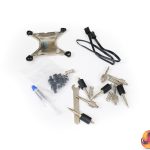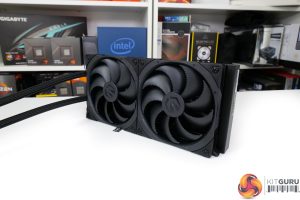
SilentiumPC has undergone a rebranding – now we are introducing Endorfy. Still designed in partnership with Synergy cooling, the Polish company is aiming to maintain its goals of offering strong price versus performance cooling hardware.
In this video, we are examining the Endorfy Navis F280 – a 280mm AIO liquid cooler that aims to offer no-frills performance cooling at a competitive price of 98 Euros. We have already reviewed the Navis F240 ARGB in SilentiumPC guise, so this review will be very similar indeed, but let’s take a quick look at the cooler and then jump into the important 280mm cooling performance.
Video Timestamps
00:00 Start
00:54 The cooler up close
05:04 Test System
06:23 Test Results
09:05 Performance/cost
09:32 Noise output
09:51 Installation thoughts
10:30 Warranty
10:50 Closing thoughts
Mounting hardware and accessories are provided for all modern Intel platforms as well as AM4/AM5. You get some cables for handling the fans and connections, plus there’s a tube of Pactum PT-3 thermal paste which I always like to see included.
A pleasant surprise was the Endorfy pre-applied the cooling fans. This gives the user one less installation task – nice!
Endorfy uses a conventional 27-28mm-thick, 280mm-class black aluminium radiator, albeit with fins that don’t span the entire thickness.
The black-coloured liquid tubes are covered by a high-quality, attractive braiding. Flexibility of the tubes is positive, especially when coupled with the reasonable degree of movement for the entry points at the pump-block unit.
A well-sized, bare copper cold plate is used to extract heat from a CPU. I prefer that the cold plate is void of pre-applied thermal paste, particularly as Endorfy includes a small tube which is sufficient for multiple applications.
Physically very chunky, the pump-block unit features integrated mounting hardware for the Intel and AMD platforms that this cooler supports. This is a unique design as most competitors use brackets for mounting capability. I guess this has the benefit of ease of installation because it’s one less part to think about, but it does have the downside of making future upgraded support of new sockets a more challenging – perhaps impossible – task.
PWM control is used for the ceramic-bearing pump. This allows the unit to operate in a speed range of 1600 to 2600 RPM, which is ideal for noise output.
There is no LED lighting on the pump housing, which will certainly appeal to some. However, the Endorfy brand logo cannot be rotated either, which is a little short-sighted.
The pair of Fluctus 140 PWM fans come pre-applied on the radiator. These fans are rated at a speed range of 250-1800 RPM via their 4-pin PWM control.
The two fans are daisy-chained together on the radiator meaning that only a single 4-pin header is required to power them. That’s smart.
Endorfy uses a Fluid Dynamic Bearing inside the fans and there are clear optimisations on the blades to suit the pressure-biased use case.
Given the smart daisy-chaining of the pre-installed fans’ cables, management is very easy. There’s just the pair of cables leaving the pump-block unit – SATA power and 4-pin PWM control. And then the 4-pin fan cable can be hidden easily behind the motherboard tray without sprawling across the CPU socket area.
Installation was very quick and easy, thanks in large to Endorfy’s pre-applied hardware. All we needed to do was insert the threaded stand-offs into the default AM4 backplate. We then applied paste and positioned the pump-block unit, and once the spring and thumbscrew were tightened, the block was in position.
Pre-applied fans made radiator installation quick and simple, and the reasonable number of cables was easy to route and deal with neatly.
As a note, the review guide we got sent said that the pump block should be installed with the Endorfy logo facing up. This isn’t really feasible for our installation approach (which has specific tubing placement to maintain test consistency). Plus, it really limits installation options for users, so I don’t think that this is necessarily a helpful suggestion from Endorfy.
Warranty is just OK on the 98 Euro Navis F280. Three years for a modern AIO cooler is fine at this price point, albeit hardly inspiring. The fans are rated at 100,000 hours MTBF, which is also absolutely fine.
But competition namely from Arctic and Corsair is strong at below £90 and those two vendors offer longer warranties.
 KitGuru KitGuru.net – Tech News | Hardware News | Hardware Reviews | IOS | Mobile | Gaming | Graphics Cards
KitGuru KitGuru.net – Tech News | Hardware News | Hardware Reviews | IOS | Mobile | Gaming | Graphics Cards

















